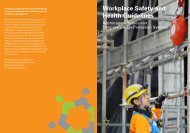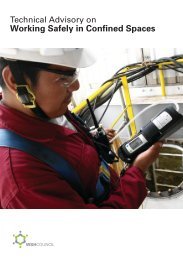Fatigue Management - Workplace Safety and Health Council
Fatigue Management - Workplace Safety and Health Council
Fatigue Management - Workplace Safety and Health Council
Create successful ePaper yourself
Turn your PDF publications into a flip-book with our unique Google optimized e-Paper software.
• Working during some or all of the natural time for sleep (as a result of shift or long work<br />
hours); <strong>and</strong><br />
• Lack of adequate rest <strong>and</strong> sleep.<br />
1.1.2 Identification of <strong>Fatigue</strong><br />
A fatigued person generally displays a set of symptoms that can be recognised but these may<br />
often not be identified as fatigue. The common symptoms of fatigue listed below can help<br />
managers <strong>and</strong> supervisors in identifying fatigue amongst employees:<br />
• Undue tiredness;<br />
• Higher level of irritability or impatience;<br />
• Person speaks less than usual or is less clear in communication;<br />
• Shorter attention span, easily distracted;<br />
• Slower reaction speed;<br />
• Compromised eye-h<strong>and</strong> coordination, increased clumsiness;<br />
• Slowed thinking;<br />
• Reduced short-term memory, forgetful;<br />
• Inability to h<strong>and</strong>le information especially under time pressure;<br />
• Reduced ability for problem solving;<br />
• Taking shortcuts to finish jobs, higher tendency of risk taking behaviour;<br />
• Poor judgement of distance, speed, <strong>and</strong>/or time;<br />
• Use/abuse of substances to cope (e.g. cigarettes, alcohol);<br />
• Loss of appetite or problems with digestion; <strong>and</strong><br />
• Excessive sleepiness with Microsleep1 .<br />
1.2 Factors Contributing to <strong>Fatigue</strong><br />
A person’s circadian rhythm or body’s biological clock can be disrupted by changes in daily<br />
schedule through various factors. These include work <strong>and</strong>/or non work-related factors.<br />
1.2.1 Work-related Factors<br />
Poor work schedules can disrupt a person’s circadian rhythm as the body has to adjust to differing<br />
times thus contributing to the onset of fatigue. For example, it can include:<br />
• Roster patterns;<br />
• Length of shifts <strong>and</strong> time worked;<br />
• Poor work scheduling <strong>and</strong> planning;<br />
• Timing of shifts (e.g. night shift);<br />
• Insufficient recovery time between shifts;<br />
• Long period of time awake; <strong>and</strong><br />
• Inadequate rest breaks.<br />
1 Microsleep is an occurrence of sleep that comes against the person’s desire. As it can occur anytime without<br />
warning <strong>and</strong> can last for seconds, this can be extremely dangerous when it occurs during situations which<br />
dem<strong>and</strong> continual alertness, for example driving <strong>and</strong> working with machinery.<br />
Other work-related factors include:<br />
• Non conducive environmental conditions (e.g., hot weather, rain, sun glare);<br />
• Type of work undertaken (mental or physical); <strong>and</strong><br />
• Sustained dem<strong>and</strong>ing work.<br />
1.2.2 Factors Outside Work<br />
Demographic characteristics:<br />
• Age (e.g. older people may be less able to cope with night shifts); <strong>and</strong><br />
• <strong>Health</strong> status (e.g. underlying medical conditions).<br />
Individual factors:<br />
• Poor quality of sleep;<br />
• Reduced sleep <strong>and</strong> rest due to social life <strong>and</strong> family needs;<br />
• Other employment (part-time jobs);<br />
• Excessive travel time (distance from home to workplace); <strong>and</strong><br />
• Sleep disorders.<br />
1.3 Effects of <strong>Fatigue</strong><br />
1.3.1 Implications <strong>and</strong> Impact<br />
<strong>Fatigue</strong> can result in sleep deprivation which can lead to:<br />
• Physical <strong>and</strong> mental impairment;<br />
• Increase in error rates;<br />
• Slow reaction times to respond to situations;<br />
• Increased risk of injuries; <strong>and</strong><br />
• Sleepiness <strong>and</strong> Microsleeps.<br />
1.3.2 Effects of <strong>Fatigue</strong> on <strong>Safety</strong> <strong>and</strong> <strong>Health</strong> Performance<br />
Short-term effects of fatigue can reduce the ability to:<br />
• Stay awake;<br />
• Concentrate on a specified task;<br />
• Pay attention to safe work practices;<br />
• React to changes in surroundings or information provided;<br />
• Make error-free decisions;<br />
• Think laterally <strong>and</strong> analytically;<br />
• Remember <strong>and</strong> recall details;<br />
• Control emotions, mood <strong>and</strong> h<strong>and</strong>le stress;<br />
• Recognise risks;<br />
• Coordinate eye-h<strong>and</strong> movements (e.g. clumsiness <strong>and</strong> instability); <strong>and</strong><br />
• Communicate well.<br />
1.3.3 Effects of <strong>Fatigue</strong> on <strong>Workplace</strong> Injuries<br />
<strong>Fatigue</strong> can affect employees’ ability to concentrate at work. This may result in:<br />
6 7

















